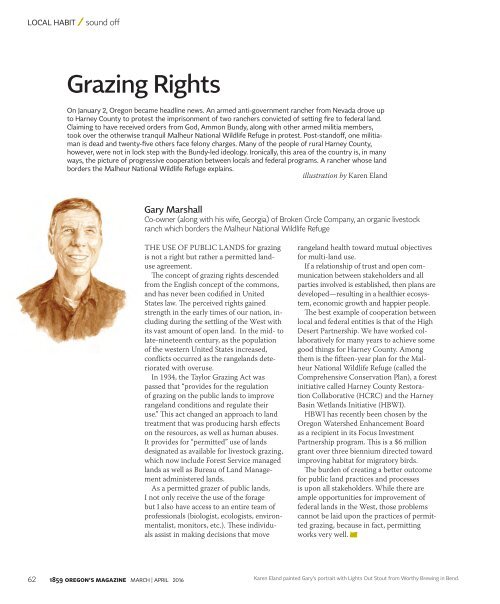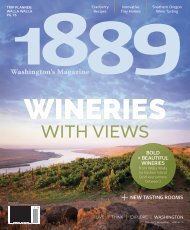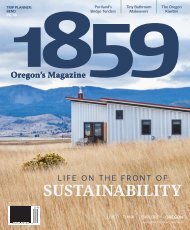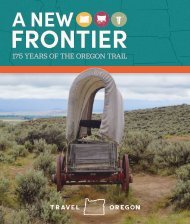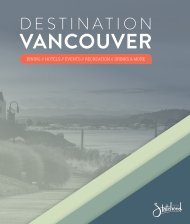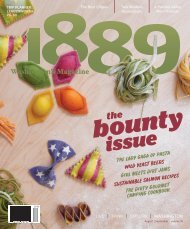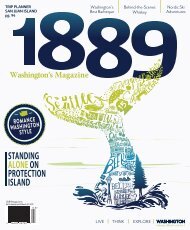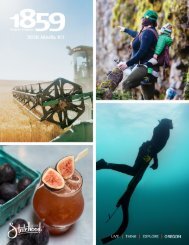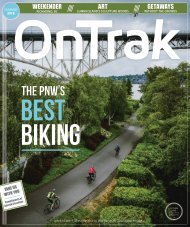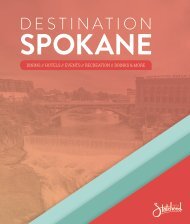You also want an ePaper? Increase the reach of your titles
YUMPU automatically turns print PDFs into web optimized ePapers that Google loves.
LOCAL HABIT<br />
sound off<br />
Grazing Rights<br />
On January 2, Oregon became headline news. An armed anti-government rancher from Nevada drove up<br />
to Harney County to protest the imprisonment of two ranchers convicted of setting fire to federal land.<br />
Claiming to have received orders from God, Ammon Bundy, along with other armed militia members,<br />
took over the otherwise tranquil Malheur National Wildlife Refuge in protest. Post-standoff, one militiaman<br />
is dead and twenty-five others face felony charges. Many of the people of rural Harney County,<br />
however, were not in lock step with the Bundy-led ideology. Ironically, this area of the country is, in many<br />
ways, the picture of progressive cooperation between locals and federal programs. A rancher whose land<br />
borders the Malheur National Wildlife Refuge explains.<br />
illustration by Karen Eland<br />
Gary Marshall<br />
Co-owner (along with his wife, Georgia) of Broken Circle Company, an organic livestock<br />
ranch which borders the Malheur National Wildlife Refuge<br />
THE USE OF PUBLIC LANDS for grazing<br />
is not a right but rather a permitted landuse<br />
agreement.<br />
The concept of grazing rights descended<br />
from the English concept of the commons,<br />
and has never been codified in United<br />
States law. The perceived rights gained<br />
strength in the early times of our nation, including<br />
during the settling of the West with<br />
its vast amount of open land. In the mid- to<br />
late-nineteenth century, as the population<br />
of the western United States increased,<br />
conflicts occurred as the rangelands deteriorated<br />
with overuse.<br />
In 1934, the Taylor Grazing Act was<br />
passed that “provides for the regulation<br />
of grazing on the public lands to improve<br />
rangeland conditions and regulate their<br />
use.” This act changed an approach to land<br />
treatment that was producing harsh effects<br />
on the resources, as well as human abuses.<br />
It provides for “permitted” use of lands<br />
designated as available for livestock grazing,<br />
which now include Forest Service managed<br />
lands as well as Bureau of Land Management<br />
administered lands.<br />
As a permitted grazer of public lands,<br />
I not only receive the use of the forage<br />
but I also have access to an entire team of<br />
professionals (biologist, ecologists, environmentalist,<br />
monitors, etc.). These individuals<br />
assist in making decisions that move<br />
rangeland health toward mutual objectives<br />
for multi-land use.<br />
If a relationship of trust and open communication<br />
between stakeholders and all<br />
parties involved is established, then plans are<br />
developed—resulting in a healthier ecosystem,<br />
economic growth and happier people.<br />
The best example of cooperation between<br />
local and federal entities is that of the High<br />
Desert Partnership. We have worked collaboratively<br />
for many years to achieve some<br />
good things for Harney County. Among<br />
them is the fifteen-year plan for the Malheur<br />
National Wildlife Refuge (called the<br />
Comprehensive Conservation Plan), a forest<br />
initiative called Harney County Restoration<br />
Collaborative (HCRC) and the Harney<br />
Basin Wetlands Initiative (HBWI).<br />
HBWI has recently been chosen by the<br />
Oregon Watershed Enhancement Board<br />
as a recipient in its Focus Investment<br />
Partnership program. This is a $6 million<br />
grant over three biennium directed toward<br />
improving habitat for migratory birds.<br />
The burden of creating a better outcome<br />
for public land practices and processes<br />
is upon all stakeholders. While there are<br />
ample opportunities for improvement of<br />
federal lands in the West, those problems<br />
cannot be laid upon the practices of permitted<br />
grazing, because in fact, permitting<br />
works very well.<br />
62 <strong>1859</strong> OREGON’S MAGAZINE MARCH | APRIL <strong>2016</strong><br />
Karen Eland painted Gary’s portrait with Lights Out Stout from Worthy Brewing in Bend.


